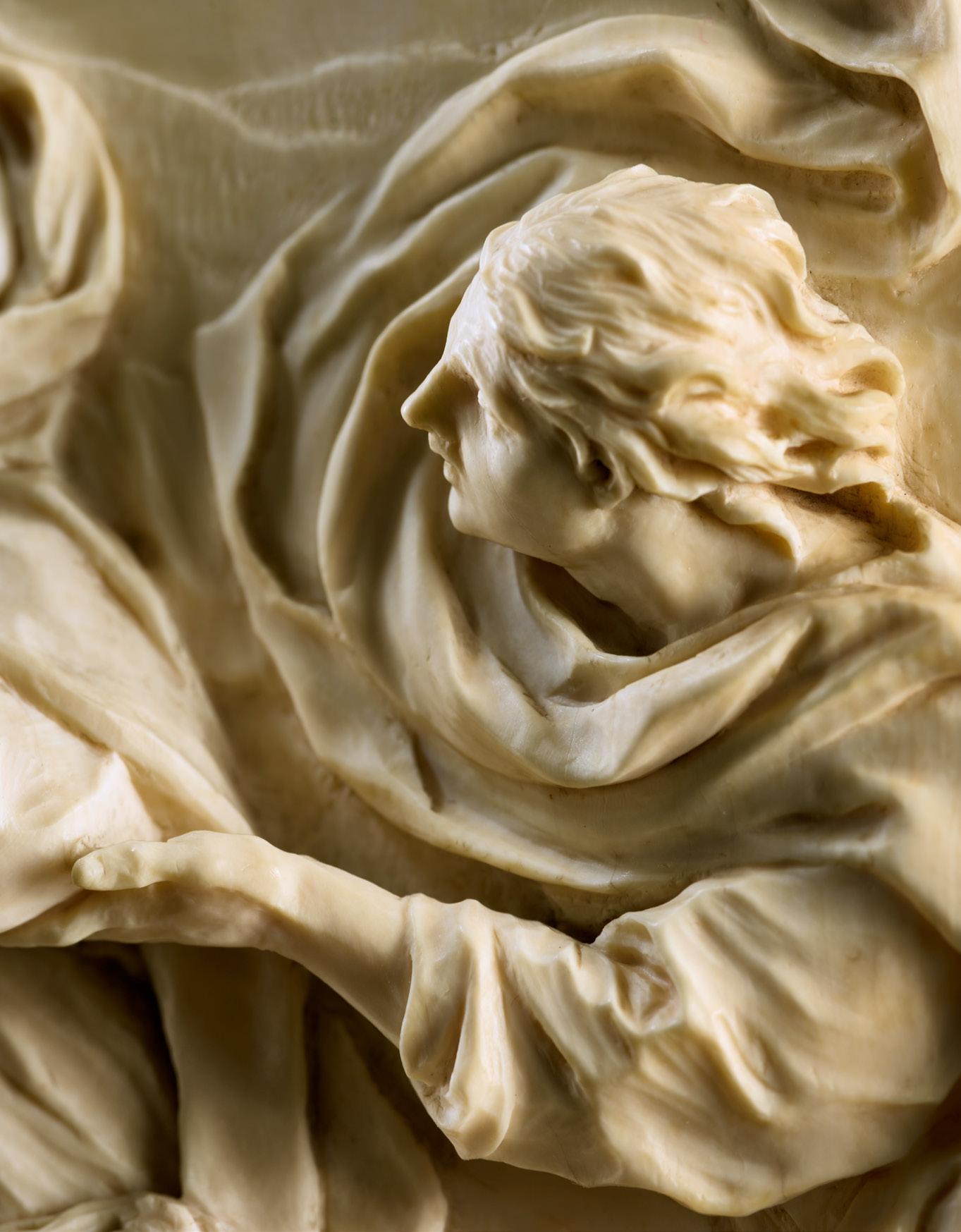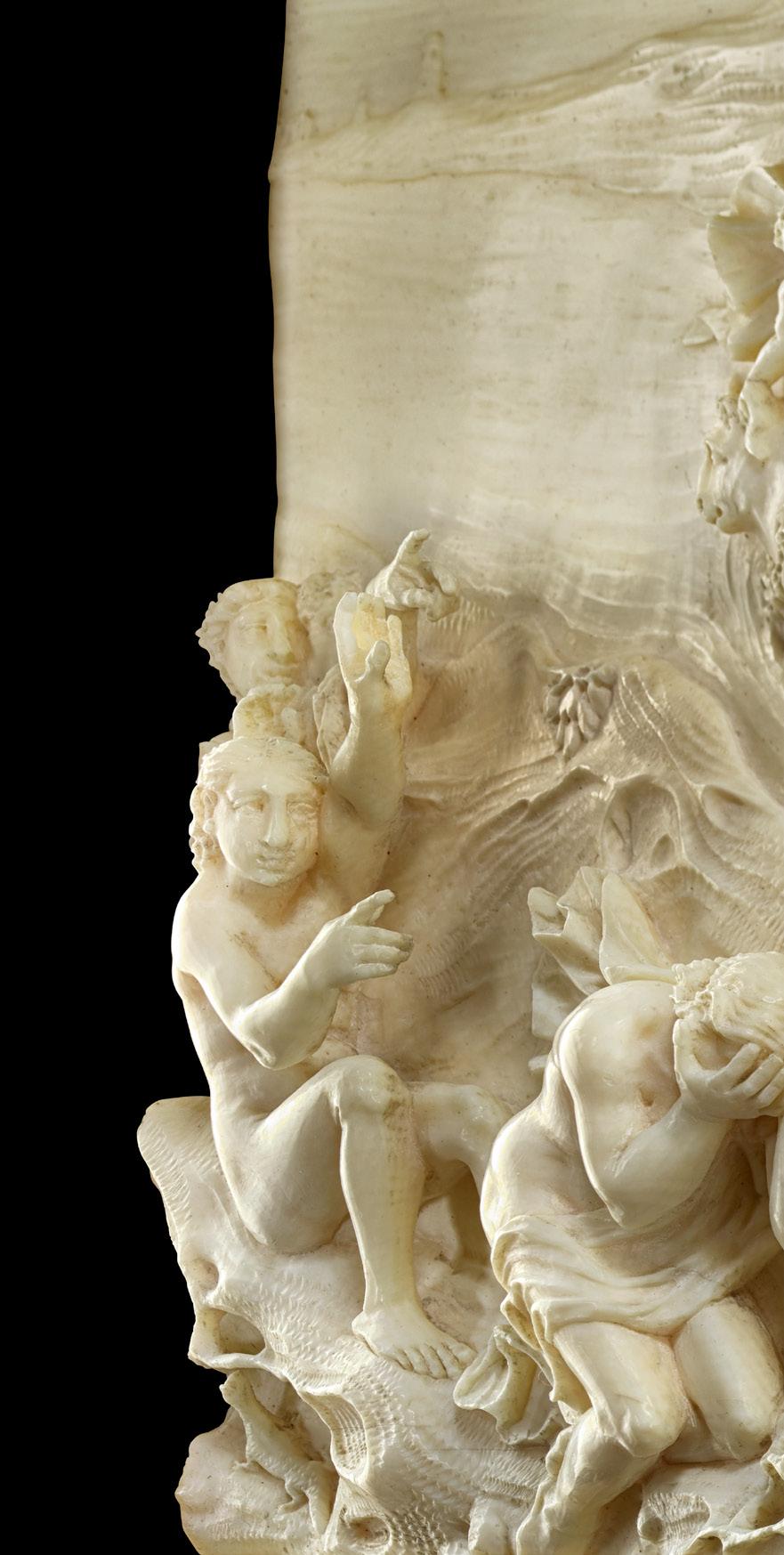
6 minute read
25 Ceres, Allegory of Summer, by Ferdinand Tietz
from JB Test 01/22
Fig. 1. Balthasar Permoser, The Entombment, 23 x 14 cm, circa. 1677/1680, ivory, London, Victoria & Albert Museum, inv. no. 30/1949
Figures carved almost in the round that step out of the virtual plane of the relief and draw closer to the viewer are juxtaposed with the graphically delicate, partly translucent and wafer-thin working of the ivory. This is evidence of a virtuosity exhibited by only a few ivory carvers in the 17th century.
Advertisement
Stylistically, the relief can clearly be classified to the œuvre of Balthasar Permoser (1651-1732). The relief of the ‘Entombment’ in the Victoria & Albert Museum (fig. 1), firmly ascribed to Balthasar Permoser, is very similar to the ‘Lamentation’. Mary Magdalene is shown here in a modified way sitting on the ground; the Virgin Mary is being supported by two women while John is about to place the corpse in the sarcophagus. The treatment of the folds in the garments and the working of the hair are comparable. The mourning putti and seraphim in the heavens ressemble the chorus of putti in the ‘Lamentation’. The execution of the landscape in the background and that of individual motifs such as the plants on the ground and Mary Magdalene’s ointment vessel are even identical.
Permoser created the London relief around 1677/1680 in Rome where he went in 1676 after his apprenticeship in Salzburg and Vienna. He studied the ivory carvings there with great intensity and, presumably, had contact with the well-known and highly skilled Flemish ivory sculptor Francis van Bossuit (1635-92) who was also in Rome at that time. Permoser must have known Bossuit’s relief of the ‘Entombment’ (c. 1675) as he adopted certain motifs, such as the putto at the very front of the relief supporting Christ’s limp body.
Permoser’s work attracted the attention of the Electoral Prince Frederick Augustus, later Elector of Saxony and King Augustus II of Poland, when on his grand tour to Italy in 1687-91. In 1689 the Elector called Permoser to Dresden as sculptor to the court.
Through his decorative sculptural work for the Zwinger, carried out from 1690 onwards during the reign of King Augustus the Strong, Permoser was to leave his mark on the city of Dresden like no other.
While in Dresden Permoser also continued to work in ivory as evidenced by his famous small ivory figures created together with the Dresden court goldsmith Johann Melchior Dinglinger (1664-1731).
26
1 Francis van Bossuit, Entombment of Christ, c. 1675, ivory, 25.8 x 15.5 x 3.4 cm, The Thomson Collection at the Art Gallery of Ontario, inv. no. AGOID.29181, link: https://ago.ca/collection/object/agoid.29174

Relief of the Rape of Europa

27



RELIEF WITH THE RAPE OF EUROPA
DOMINIKUS STAINHART Weilheim, 1655-1712, Munich
Late 17th century
Ivory Height: 10.8 cm, width: 20 cm
Monogram in the lower, left-hand corner: DS
Related literature:
Kessler, Hans-Ulrich. ‘Die Elfenbeinreliefs aus der Werkstatt der Gebrüder Stainhart’, in: Elfenbein, Alabaster und Porzellan aus der Sammlung des fürstbischöflichen Ministers Ferdinand von Plettenberg und der Freiherren von Ketteler, Stadtmuseum Münster, Patrimonia 193, Kulturstiftung der Länder, 2001, p. 48-73. Theuerkauff, Christian. ‘Kunststücke von Helfenbein. Zum Werk der Gebrüder Stainhart’, in: Alte und Moderne Kunst, Vienna, 16 (1972), 124/5, part 1, pp. 22-29, part II, pp. 30-33.
Feuchtmayr, Karl. ‘Dominicus Stainhart’, in: Thieme, Ulrich/Becker, Felix (eds.), Allgemeines Lexikon der bildenden Künstler von der Antike bis zur Gegenwart, vol. 31, Leipzig 1937, pp. 450-451. Europa was a Phoenician princess with whom Zeus fell in love. While playing with her companions on the beach of Sidon the god changed his appearance into that of a white bull and approached the maiden, lay down and let himself be stroked. After Europa had climbed, quite unsuspectingly, onto the bull’s back he ran off with her into the water and swam away. He reached the island of Crete where he revealed his true identity. She bore him three sons: Sarpedon, Minos, the later king of Crete, and Rhadamanthus, the judge of the dead.
Stainhart chose the dramatic moment of the abduction: Zeus, in the form of the mighty bull, carries the beautiful young princess over the stormy seas. Stainhart shows Europa’s distraught, gesticulating companions at the front of the composition in an extremely convincing manner.
The relief is characterised by the composition of its pictorial narrative. The dynamic, animated figures in the foreground are virtually completely undercut and almost freestanding. By contrast, the execution of the middle ground, with the depiction of Europa and the bull, as well as the background, is almost flat. These compositional features are typical of the ivory carver Dominikus Stainhart (1655-1712) who signed the relief, below right, with his monogram ‘DS’. The faces with straight noses, the hairstyles with plaits and ribbons, the draping of the garments and the furrows in the surface of the tree and water all point to the style of this sculptor from Upper Bavaria.
Dominikus Stainhart came from a family of carvers from Weilheim. From 1674 until 1682 he travelled around Italy with his brother, Franz (1651-1695). Evidence exists that he was in Rome from 1678 until 1680 where he worked for the princely families of Radziwill and Colonna.
27
A display cabinet that Dominikus decorated with ivory reliefs can still be seen in the Palazzo Colonna. It comprises a large, arched relief with a sculpted depiction of Michelangelo’s ‘Last Judgment’ and twenty-seven, small-format reliefs showing scenes from the Old and the New Testament. The overall composition for the display cabinet was designed by the architect Carlo Fontana who presumably specified the reliefs to be selected.1
In 1682 both brothers returned home to Weilheim and in 1690 Dominikus moved to Munich where he is mentioned by name as beeing on the committee of the Guild of Sculptors in Munich in 1705.2 This not only suggests that he was a member but also testifies to his standing as a sculptor. In early 1683 Dominikus sought a position at the Bavarian Court in Munich but without success. Nevertheless he he sold a series of six reliefs depicting tales from the Book of Moses to the Elector of Bavaria, Max Emanuel.3 Around 1792 he delivered two pieces of ivory to the ducal „Kunstkammer“ in Munich and after his death his wife received payment for further four reliefs. The Bayerisches Nationalmuseum houses other works by Stainhart including one ‘D. Stainhart’ signed and three ‘DS’ monogrammed reliefs: Diana and her Nymphs Surprised by Satyrs, Venus and the Dead Adonis, Apollo Slaying Coronis, and Apollo and Daphne – all originally from the ‘Stroganoff Collection, Leningrad’.5

1 Theuerkauff, op.cit., pp. 22f. and ill. 3. 2 Feuchtmayr, op. cit., p. 450. 3 These are now in the Bayerisches Nationalmuseum, Munich. 4 „2 helffenpainene stuck“, Feuchtmayr, op. cit., p. 450. 5 acquired in 1931 by the Bayerisches Nationalmuseum, Munich; Diana and her Nymphs Surprised by Satyrs, monogrammed „DS“, c. 1690-1700, inv. no. 31/273; Venus and the Dead Adonis, monogrammed „DS“, inv. no. 31/272; Apollo Slaying Coronis, monogrammed „DS“, inv. no. 31/271; Apollo and Daphne signed „D.Stainhart“ 31/270.










